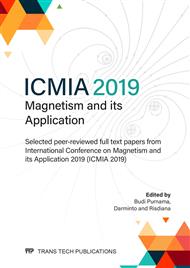[1]
Zhao, G., Zhang, X., & Morvan, F. Theory for the coercivity and its mechanisms in nanostructured permanent magnetic materials., Reviews in Nanoscience and Nanotechnology,. 4(1) (2015) 1-25.
DOI: 10.1166/rnn.2015.1063
Google Scholar
[2]
Liu JF, Vora P, Walmer M, Overview of recent progress in Sm-Co based magnets,, J. Iron Steel Res. Int. 13 (2006) 319.
DOI: 10.1016/s1006-706x(08)60202-2
Google Scholar
[3]
De Campos MF, Landgraf FJ, Determination of intrinsic magnetic parameters of SmCo5 phase in sintered samples,, InMaterials science forum 498 (2005) 129-133.
DOI: 10.4028/www.scientific.net/msf.498-499.129
Google Scholar
[4]
De. Campos, MF. Okumura H. Hadjipanayis, GC. Rodrigues, D. Landgraf, FJ. Neiva, AC. Romero, SA. Missell FP, Effect of several heat treatments on the microstructure and coercivity of SmCo5 magnets,, J Alloy Compd 368(1) (2004) 304.
DOI: 10.1016/s0925-8388(03)00671-6
Google Scholar
[5]
Zhang W, Rui ZH, Yikun FA, Mingge ZH, Minggang ZH, Wei LI, Effect of Sm-rich liquid phase on magnetic properties and microstructures of sintered 2:17-type Sm-Co magnet," J. Rare Earths., 29(10) (2011) 934.
DOI: 10.1016/s1002-0721(10)60572-8
Google Scholar
[6]
Croat, J.J.; Herbst, J.F.; Lee, R.W. & Pinkerton, F.E. (1984). High-energy product Nd-Fe-B permanent magnets. Applied Physics Letters, Vol. 44, No. 1 (1 January 1984) 148-149.
DOI: 10.1063/1.94584
Google Scholar
[7]
Kaneko, Y.; Kuniyoshi, F. & Ishigaki, N. (2006). Proven technologies on high-performance Nd-Fe-B sintered magnets. Journal of Alloys and Compounds, Vol. 408-412 ((9 February 2006) 1344-1349.
DOI: 10.1016/j.jallcom.2005.04.169
Google Scholar
[8]
Yang, X., Li, Q., Microstructure Characteristic and Excellent Corrosion Protection Properties of Sealed ZnTiO2 Composite Coating for Sintered NdFeB Magnet. In: Journal of Alloys and Compounds 495 (2010), pp.189-195.
DOI: 10.1016/j.jallcom.2010.01.117
Google Scholar
[9]
Yu, S., Ling, C.: Preparation Technology and Performances of Zn-Cr Coating on Sintered NdFeB Magnet. In: Journal of Rare Earths 24 (2006), pp.223-226.
DOI: 10.1016/s1002-0721(06)60098-7
Google Scholar
[10]
Rada, M.; Lyubina, J.; Gebert, A.; Gutfleisch, O. & Schultz, L. (2005). Corrosion behavior of Nd-Fe-B/alpha-Fe nanocomposite magnets. Journal of Magnetism and Magnetic Materials, Vol. 290, Part 2 (April 2005) 1251-1254.
DOI: 10.1016/j.jmmm.2004.11.415
Google Scholar
[11]
Talijan, N.M. (2006). Magnetic properties of sintered high energy Sm-Co and Nd-Fe-B magnets. Science of Sintering, Vol. 38, No. 1 (January-April 2006) 73-82.
DOI: 10.2298/sos0601073t
Google Scholar
[12]
Betancourt, I. & Davies, H.A. (2010). Exchange coupled nanocomposite hard magnetic alloys. Materials Science and Technology, Vol. 26, No. 1 (January 2010) 5-19.
DOI: 10.1179/026708309x12548155118860
Google Scholar
[13]
Kazuhiko Yamamoto1, and Ryo Murakami, Microstructural Analysis of NdFeB Ternary Alloy for Magnets Fabricated Using a Strip-Casting Method, Materials Transactions, Vol. 57, No. 8 (2016) p.1266 – 1271.
DOI: 10.2320/matertrans.mg201624
Google Scholar
[14]
Cha, H.; Kim, C.; Ji, E.; Kim, Y.; Jadhav, A.; Kang, D. & Kang, Y. (2010). Enhanced exchange coupling effect in Nd-Fe-B/Fe-B nanocomposite magnet. Journal of Nanoscience and Nanotechnology, Vol. 10, No. 1 (January 2010) 186-190.
DOI: 10.1166/jnn.2010.1538
Google Scholar
[15]
MV Purwani, Suyanti Suyanti, Wisnu Ari Adi, Thermal Decomposition Kinetics of Lanthanum Oxalate Hydrate Product Treatment From Monazite, 2019, Journal Jusami, Indonesian Journal of Materials Science, Volume 20, Issue 2, Pages 50-57, DOI: http://dx.doi.org/10.17146/jusami.2019.20.2.5295.
DOI: 10.17146/jsmi.2019.20.2.5295
Google Scholar
[16]
I Haritsah, WA Adi, MV Purwani, A Manaf, Improved separation of Ce, La, and Nd from a concentrate of rare-earth hydroxide via fractional precipitation, 2019, Journal IOP Conference Series: Materials Science and Engineering, Volume 496, Issue 1, Pages 012013, Publisher IOP Publishing,.
DOI: 10.1088/1757-899x/496/1/012013
Google Scholar
[17]
Ohnaka, I. (1985). Melt spinning into a liquid cooling medium. International Journal of Rapid Solidification, Vol. 1, No. 3 (1985) 219-236.
Google Scholar
[18]
Kosuke Nagashio, Mingjun Li and Kazuhiko Kuribayashi, Containerless Solidification and Net Shaping by Splat Quenching of Undercooled Nd2Fe14B Melts, Materials Transactions, Vol. 44, No. 5 (2003) p.853 to 860.
DOI: 10.2320/matertrans.44.853
Google Scholar
[19]
X. B. Liu and Z. Altounian. The Partitioning of Dy and Tb in NdFeB Magnets: A First-Principles Study. Journal of Applied Physics, 111:07A701/1-07A701/3, (2012).
DOI: 10.1063/1.3670054
Google Scholar
[20]
A. K. Pathak, M. Khan, . A. Gschneidner, Jr., R. W. Mc-Callum, L. Zhou, K. Sun, K. W. Dennis, C. Zhou, F. E. Pinkerton, M. J. Kramer, and V. K. Pecharsky. Cerium: An Unlikely Replacement of Dysprosium in High Performance Nd-Fe-B Permanent Magnets. Advanced Materials, page Ahead of Print, (2015).
DOI: 10.1002/adma.201404892
Google Scholar
[21]
Idris, M. S., Osman, R. A. M., 2013. Structure Refinement Strategy of Li-Based Complex Oxides Using GSAS-EXPGUI Software Package. Advanced Materials Research, Vol. 795: 479-482.
DOI: 10.4028/www.scientific.net/amr.795.479
Google Scholar
[22]
Isnard O, Yelon W B, Miraglia S, Fruchart D, Neutron-diffraction study of the insertion scheme of hydrogen in Nd2Fe14B,, Journal of Applied Physics 78(3), 1892-1898 (1995).
DOI: 10.1063/1.360720
Google Scholar
[23]
Manaf, A.; Buckley, R.A. & Davies H.A. (1993). New nanocrystalline high-remanence Nd-Fe-B alloys by rapid solidification. Journal of Magnetism and Magnetic Materials, Vol. 128, No. 3 (December 1993) 302-306.
DOI: 10.1016/0304-8853(93)90475-h
Google Scholar


